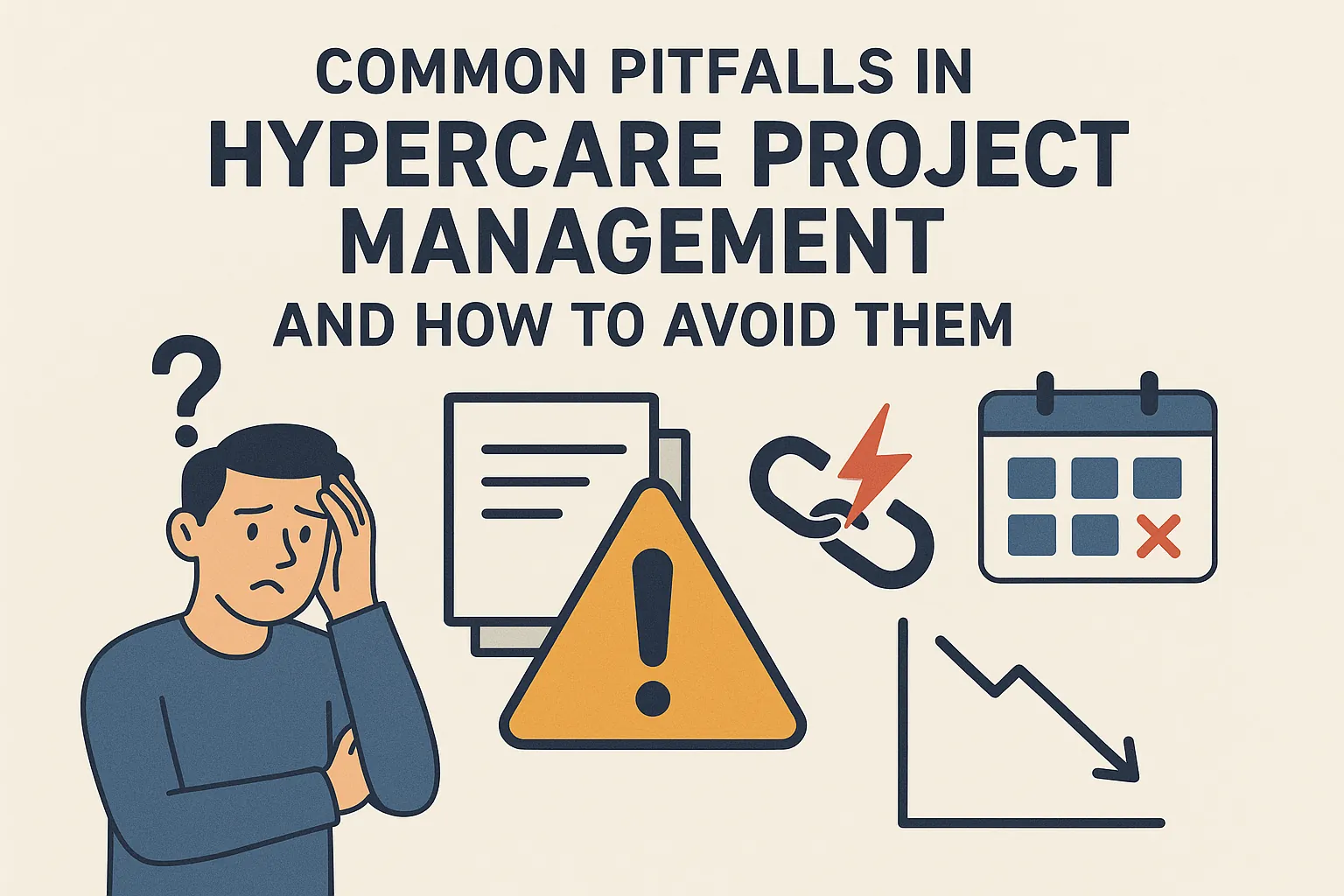Introduction to Hypercare Project Management
Hypercare refers to the critical phase that follows the launch of a new system or significant updates. This period is characterized by heightened support and monitoring to ensure a smooth transition and to address any issues that may arise promptly. Hypercare is not merely an afterthought; it is a strategic component that can significantly influence the overall success of a project and the satisfaction of stakeholders.
Definition of Hypercare in Project Management
Hypercare is often described as a concentrated support phase that occurs immediately after the implementation of a project. It typically lasts from a few weeks to several months, depending on the complexity of the project. During this time, the project team closely monitors the system’s performance, addresses user feedback, and resolves any bugs or issues that users encounter. This proactive approach is essential for identifying and rectifying problems before they escalate, ensuring that the project meets its intended goals and delivers value to its users [1][10][12].
Importance of Hypercare for Project Success and Stakeholder Satisfaction
The significance of hypercare in project management cannot be overstated. It serves multiple functions that are vital for project success:
- Issue Identification: Hypercare allows users to report immediate problems, enabling the project team to address them quickly and effectively [10].
- User Support: Providing additional support during this phase helps users acclimate to the new system, fostering a positive experience and reducing frustration [11].
- Stakeholder Confidence: By demonstrating a commitment to resolving issues and ensuring system functionality, project teams can enhance stakeholder trust and satisfaction [11][12].
Ultimately, hypercare plays a crucial role in ensuring that the project not only meets its objectives but also aligns with the expectations of stakeholders, thereby contributing to long-term success.
Overview of the Blog’s Focus on Common Pitfalls and Solutions
This blog will delve into the common pitfalls associated with hypercare project management, highlighting frequent mistakes that project managers and team leaders may encounter. These pitfalls can include staff burnout, inadequate preparation, poor issue prioritization, and inconsistent training [2][3][4]. By identifying these challenges, the blog aims to provide actionable solutions and best practices that can help project teams navigate the hypercare phase more effectively. Through this exploration, we hope to equip project managers and team leaders with the knowledge and tools necessary to enhance their hypercare strategies, ultimately leading to more successful project outcomes and satisfied stakeholders.
Understanding the Hypercare Phase
The hypercare phase is a critical component of project management, particularly following the deployment of new systems or significant updates. It serves as a concentrated period of support aimed at ensuring a smooth transition and addressing any immediate issues that may arise post-implementation.
Description of the Hypercare Phase and Its Objectives
Hypercare refers to the phase that occurs immediately after the launch of an application or system in production. Its primary objective is to closely monitor the application to swiftly respond to and resolve any issues that users may encounter. This phase is essential for identifying and addressing bugs, user errors, and system instabilities that could hinder the project’s success. By providing supplemental support during this time, project teams can enhance user satisfaction and ensure a successful transition to the new system [1][10].
Typical Duration and Activities Involved in Hypercare
The duration of the hypercare phase can vary, typically spanning from a few weeks to several months, depending on the complexity of the project. During this period, project teams engage in various activities, including:
- Monitoring System Performance: Continuous observation of the system to identify any performance issues or bugs that may arise.
- User Feedback Collection: Actively soliciting feedback from users to understand their experiences and any challenges they face [11].
- Issue Resolution: Prioritizing and addressing reported issues promptly to minimize downtime and enhance user experience [7][12].
- Training and Support: Providing additional training and resources to users to help them adapt to the new system effectively [3][4].
These activities are crucial for ensuring that the project meets its objectives and that users feel supported during the transition.
How Hypercare Fits into the Overall Project Management Framework
Hypercare is an integral part of the project management lifecycle, often positioned as a bridge between the implementation phase and the ongoing support phase. It emphasizes the importance of a smooth handoff from project teams to operational teams, ensuring that all aspects of the project are functioning as intended before full-scale operations commence.
Incorporating hypercare into the project management framework allows for:
- Proactive Issue Management: By addressing potential problems early, project teams can prevent minor issues from escalating into major setbacks [15].
- Enhanced User Adoption: Providing robust support during hypercare fosters user confidence and encourages adoption of the new system [10].
- Continuous Improvement: Feedback gathered during this phase can inform future projects and improvements, creating a cycle of learning and adaptation within the organization [11].
Common Pitfalls in Hypercare Project Management
The hypercare phase is a critical period following the launch of a project, where the focus is on providing additional support to ensure a smooth transition and address any issues that arise. However, this phase is often fraught with challenges that can hinder its effectiveness. Here are some common pitfalls in hypercare project management and strategies to avoid them:
- Inadequate Stakeholder Communication and Engagement: One of the most significant mistakes during hypercare is failing to maintain open lines of communication with stakeholders. This can lead to misunderstandings and a lack of support. To mitigate this, project managers should establish regular check-ins and updates to keep stakeholders informed and engaged throughout the hypercare period. This ensures that everyone is aligned and can contribute to problem-solving efforts effectively [1][4].
- Failure to Establish Clear Roles and Responsibilities: Without clearly defined roles, team members may be unsure of their responsibilities, leading to confusion and inefficiencies. It is essential to outline specific roles for each team member involved in the hypercare phase. This clarity helps streamline processes and ensures that issues are addressed promptly by the appropriate individuals [2][12].
- Neglecting Documentation and Knowledge Transfer: Documentation is crucial for capturing lessons learned and ensuring that knowledge is transferred effectively within the team. Neglecting this aspect can result in repeated mistakes and a lack of continuity. Project managers should prioritize creating comprehensive documentation during the hypercare phase, including user feedback, issue resolutions, and best practices, to facilitate future projects and support ongoing learning [3][11].
- Insufficient Resource Allocation and Team Support: Hypercare often requires additional resources to address the influx of issues and user feedback. Insufficient allocation of resources can lead to staff burnout and delayed resolutions. Project managers should assess the needs of the hypercare phase and allocate adequate resources, including personnel and tools, to support the team effectively. This proactive approach helps maintain morale and ensures that issues are resolved in a timely manner [2][7].
- Ignoring Feedback and Not Adapting to Changes: Feedback from users during the hypercare phase is invaluable for identifying issues and improving the system. Ignoring this feedback can lead to unresolved problems and user dissatisfaction. Project managers should actively solicit and analyze user feedback, making necessary adjustments to the project as needed. This adaptability not only enhances the user experience but also fosters a culture of continuous improvement within the team [10][14].
Solutions to Avoid Hypercare Pitfalls
It is crucial to recognize and address common pitfalls that can hinder the success of a project. Here are actionable strategies that project managers and team leaders can implement to navigate these challenges effectively:
- Establish a Robust Communication Plan: Effective communication is vital during the hypercare phase. A well-defined communication plan ensures that all stakeholders are kept informed about project developments, issues, and resolutions. Regular updates and check-ins can help mitigate misunderstandings and keep everyone aligned on project goals and progress [1][3].
- Define and Communicate Clear Roles and Responsibilities: Clarity in roles and responsibilities within the project team is essential to avoid confusion and overlap. By clearly defining who is responsible for what, team members can focus on their tasks without ambiguity, leading to more efficient problem resolution and project execution [5][8].
- Create Comprehensive Documentation and Ensure Knowledge Transfer: Documentation plays a critical role in hypercare. Comprehensive records of processes, decisions, and lessons learned should be maintained to facilitate knowledge transfer among team members. This practice not only aids in onboarding new team members but also serves as a reference for troubleshooting and future projects [4][7].
- Allocate Sufficient Resources and Provide Ongoing Support: Resource constraints can significantly impact the effectiveness of hypercare. It is essential to allocate adequate internal resources and, if necessary, engage external vendors to address issues promptly. Ongoing support for the team, including training and access to necessary tools, can enhance their ability to manage challenges effectively [2][3].
- Implement a Feedback Loop and Be Open to Adapting Based on Team Input: Establishing a feedback loop allows team members to voice their concerns and suggestions. Being receptive to this input can lead to improvements in processes and strategies, ultimately enhancing the overall effectiveness of the hypercare phase. Regularly soliciting feedback and making adjustments based on team insights fosters a collaborative environment and promotes continuous improvement [6][9].
By implementing these strategies, project managers and team leaders can significantly reduce the risks associated with hypercare and ensure a smoother transition from project mode to operational stability.
Best Practices for Effective Hypercare Management
Hypercare project management is a critical phase that follows the implementation of a new system or process. It ensures that any issues are promptly addressed and that the transition to normal operations is smooth. However, there are common pitfalls that project managers and team leaders can encounter during this phase. Here are some best practices to avoid these mistakes and ensure effective hypercare management:
- Utilize Project Management Tools: Implementing robust project management tools can significantly enhance tracking of progress and issues during the hypercare phase. These tools allow teams to document problems, assign responsibilities, and monitor resolutions in real-time, ensuring that nothing falls through the cracks. This structured approach helps maintain clarity and accountability among team members [5].
- Schedule Regular Check-ins and Reviews: Establishing a routine of regular check-ins and reviews with the project team is essential. These meetings provide an opportunity to discuss ongoing issues, assess the effectiveness of solutions, and adjust strategies as necessary. Regular communication helps keep everyone aligned and focused on the project’s goals, reducing the risk of misunderstandings and oversight [4].
- Foster a Culture of Open Communication and Collaboration: Encouraging open communication among team members is vital for successful hypercare management. A collaborative environment allows team members to voice concerns, share insights, and propose solutions without hesitation. This culture not only enhances problem-solving but also boosts team morale and engagement, which is crucial during the often stressful hypercare period [4].
- Leverage Data Analytics: Utilizing data analytics can provide valuable insights into performance metrics during hypercare. By analyzing data, project managers can identify trends, pinpoint recurring issues, and make informed decisions based on empirical evidence. This proactive approach enables teams to address potential problems before they escalate, ensuring a smoother transition to normal operations [3].
- Plan for Transition to Normal Operations: It is essential to have a clear plan for transitioning from hypercare to normal operations. This includes defining the criteria for when hypercare support will end and ensuring that all team members are prepared for the shift. A well-structured transition plan helps mitigate confusion and ensures that the organization can maintain operational efficiency post-hypercare [6].
By implementing these best practices, project managers and team leaders can navigate the hypercare phase more effectively, minimizing common pitfalls and enhancing the overall success of their projects.
Conclusion
Particularly during the hypercare phase, it is crucial to recognize and avoid common pitfalls that can hinder project success. Hypercare, the critical period following a project’s go-live, demands meticulous attention to detail and proactive management to ensure a smooth transition and optimal system performance.
Key Takeaways:
- Importance of Avoiding Common Pitfalls: Project managers must be vigilant about challenges such as staff burnout, inadequate preparation, and poor issue prioritization. These issues can lead to significant delays and impact the overall effectiveness of the project [1][7]. By understanding these pitfalls, teams can better prepare and mitigate risks associated with hypercare support.
- Implementing Solutions and Best Practices: It is essential to adopt best practices that enhance the hypercare experience. This includes ensuring consistent training, accurate user reporting, and prioritizing critical issues effectively. By addressing these areas, project teams can reduce downtime and improve user satisfaction [1][6][9].
- Encouragement for Sharing Experiences: Finally, project managers and team leaders are encouraged to share their experiences and insights regarding hypercare management. Engaging in discussions about what has worked and what hasn’t can foster a collaborative environment where best practices are shared, ultimately leading to more successful project outcomes.
By proactively managing the hypercare phase and learning from past experiences, project managers can significantly enhance the effectiveness of their projects and ensure a smoother transition for all stakeholders involved.
Find out more about Shaun Stoltz https://www.shaunstoltz.com/about/.
This post was written by an AI and reviewed/edited by a human.



